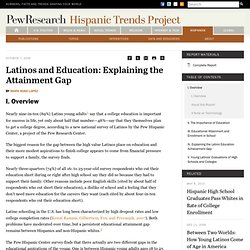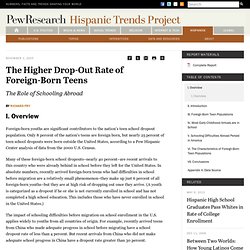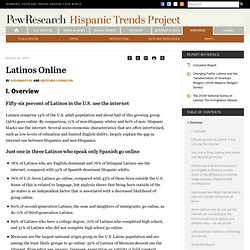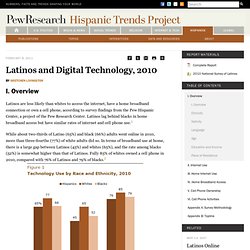

385.full.pdf (application/pdf Object) Latinos and Education: Explaining the Attainment Gap - Pew Hispanic Center. By Mark Hugo Lopez I.

Overview Nearly nine-in-ten (89%) Latino young adults say that a college education is important for success in life, yet only about half that number—48%—say that they themselves plan to get a college degree, according to a new national survey of Latinos by the Pew Hispanic Center, a project of the Pew Research Center. The biggest reason for the gap between the high value Latinos place on education and their more modest aspirations to finish college appears to come from financial pressure to support a family, the survey finds. Nearly three-quarters (74%) of all 16- to 25-year-old survey respondents who cut their education short during or right after high school say they did so because they had to support their family. Latino schooling in the U.S. has long been characterized by high dropout rates and low college completion rates (Kewal Ramani, Gilbertson, Fox, and Provasnik, 2007).
But a second gap is even bigger, and it largely explains the first gap. About this Report. Recent Changes in the Entry of Hispanic and White Youth into College - Pew Hispanic Center. The Role of Schooling Abroad By Richard Fry I.

Overview Foreign-born youths are significant contributors to the nation’s teen school dropout population. Only 8 percent of the nation’s teens are foreign born, but nearly 25 percent of teen school dropouts were born outside the United States, according to a Pew Hispanic Center analysis of data from the 2000 U.S. Many of these foreign-born school dropouts–nearly 40 percent–are recent arrivals to this country who were already behind in school before they left for the United States. The Latino Digital Divide: The Native Born versus The Foreign Born - Pew Hispanic Center. Latinos Online - Pew Hispanic Center. By Susannah Fox and Gretchen Livingston I.

Overview Fifty-six percent of Latinos in the U.S. use the internet Latinos comprise 14% of the U.S. adult population and about half of this growing group (56%) goes online. By comparison, 71% of non-Hispanic whites and 60% of non- Hispanic blacks use the internet. Just one in three Latinos who speak only Spanish go online 78% of Latinos who are English-dominant and 76% of bilingual Latinos use the internet, compared with 32% of Spanish-dominant Hispanic adults.76% of U.S. Differences in levels of education and English proficiency explain much of the difference in internet usage between Hispanics and non-Hispanics Internet use is uniformly low for whites (32%), Hispanics (31%), and African Americans (25%) who have not completed high school. Language is also a powerful factor, as internet use is much higher among Latinos who speak and read English fluently than among those who have limited English abilities or who only speak Spanish.
About this Report. Latinos and Digital Technology, 2010 - Pew Hispanic Center. By Gretchen Livingston I.

Overview Latinos are less likely than whites to access the internet, have a home broadband connection or own a cell phone, according to survey findings from the Pew Hispanic Center, a project of the Pew Research Center. Latinos lag behind blacks in home broadband access but have similar rates of internet and cell phone use. While about two-thirds of Latino (65%) and black (66%) adults went online in 2010, more than three-fourths (77%) of white adults did so. Hispanics, on average, have lower levels of education and earn less than whites. Hispanics, on average, are also younger than whites. National Latino Leader? The Job is Open - Pew Hispanic Center. By Paul Taylor and Mark Hugo Lopez I.

Overview By their own reckoning, Latinos living in the United States do not have a national leader. When asked in an open-ended question to name the person they consider “the most important Latino leader in the country today,” nearly two-thirds (64%) of Hispanic respondents said they did not know. An additional 10% said “no one.” These findings emerge from the 2010 National Survey of Latinos, a bilingual national survey of 1,375 Hispanic adults conducted prior to this month’s mid-term elections by the Pew Hispanic Center, a project of the Pew Research Center. The most frequently named individual was Sonia Sotomayor, appointed last year to the U.S. No one else was named by more than 1% of respondents in the 2010 National Survey of Latinos conducted August 17 through September 19, 2010, by landline and cellular telephone.
At 47 million strong, Latinos are the nation’s largest minority group, constituting more than 15% of the U.S. population. Hispanics Account for More than Half of Nation's Growth in Past Decade - Pew Hispanic Center. Census 2010: 50 Million Latinos By Jeffrey S.

Passel, D’Vera Cohn and Mark Hugo Lopez. EBSCOhost: Diversity and the MLS. JSTOR: The Library Quarterly, Vol. 78, No. 2 (April 2008), pp. 153-177. HW Wilson: Main Content. Between Two Worlds: How Young Latinos Come of Age in America - Pew Hispanic Center. I.

Overview and Executive Summary This is part of a Pew Research Center series of reports exploring the behaviors, values and opinions of the teens and twenty-somethings that make up the Millennial Generation Updated Edition, July 01, 2013 Hispanics are the largest and youngest minority group in the United States. One- in-five schoolchildren is Hispanic. This report takes an in-depth look at Hispanics who are ages 16 to 25, a phase of life when young people make choices that—for better and worse—set their path to adulthood. The report explores the attitudes, values, social behaviors, family characteristics, economic well-being, educational attainment and labor force outcomes of these young Latinos. The data paint a mixed picture. These are attitudes and behaviors that, through history, have often been associated with the immigrant experience.